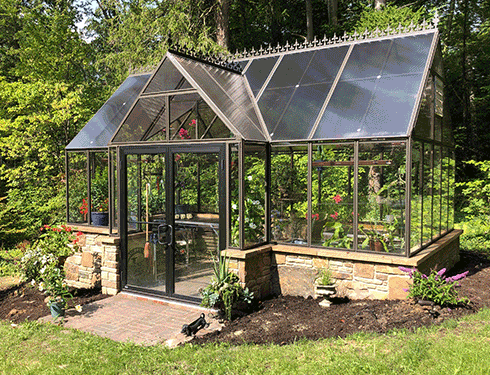Industrial Growing Solutions: Monarch Commercial Greenhouse Utah Innovations
Wiki Article
The Future of Greenhouses: Advancements in Lasting Agriculture
Are you curious about the future of greenhouses and just how they are transforming lasting farming? From sophisticated climate control systems to vertical farming methods, water-efficient watering techniques, eco-friendly energy integration, and wise data analytics, these advancements are changing the method we grow our food.Advanced Climate Control Systems
To accomplish optimal growing problems, you can depend on the innovations in greenhouses with innovative environment control systems. These systems have actually changed the means we cultivate crops, offering a controlled setting that is helpful to plant growth. With these innovative systems, you can currently adjust temperature, humidity, light levels, and also CO2 concentrations to produce the best conditions for your plants to flourish.One of the key features of these innovative environment control systems is their capability to control temperature. By utilizing sensing units and automated controls, the greenhouse can adjust the temperature based upon the particular needs of the plants. This makes sure that they are never ever exposed to severe warm or cold, which can be damaging to their growth.
Moisture control is one more important facet of these systems. By keeping the optimal moisture levels, you can avoid issues such as mold and mildew, mildew, and condition from affecting your crops. These systems can also control the amount of light that reaches the plants, making certain that they get the optimal amount for photosynthesis.
In addition, progressed environment control systems can also adjust CO2 focus. By boosting the degrees of CO2 in the greenhouse, you can improve plant growth and productivity. This is particularly beneficial in areas with reduced natural CO2 degrees.
Vertical Farming Strategies
One crucial upright farming method is using stacked expanding systems. Monarch Greenhouse Sheds Utah. These systems entail setting up plants in numerous layers, up and down piled on top of each other. By utilizing vertical area, farmers can optimize their plant return without needing additional land. Stacked expanding systems are typically utilized in metropolitan locations where area is restricted.One prominent method is understood as vertical hydroponics, where plants are grown in nutrient-rich water without soil. This technique is extremely effective as it minimizes water use by as much as 90% compared to conventional farming techniques. Additionally, because the plants are grown indoors, they are safeguarded from bugs and illness, minimizing the requirement for pesticides.
Another technique is aeroponics, which entails putting on hold the plant roots in a haze or air setting. This technique permits optimum nutrient absorption and oxygenation, leading to faster growth and greater yields. Aeroponics additionally utilizes less water than conventional farming and can be implemented in upright systems, making it a prominent choice for upright farming.
Water-efficient Irrigation Approaches
Taking full advantage of water conservation is essential when it comes to carrying have a peek at this site out water-efficient irrigation approaches in sustainable farming. With international water shortage coming to be a pressing concern, it is important to develop innovative strategies that optimize water use in greenhouse procedures.One promising approach is drip irrigation, which provides water straight to the plant origins, decreasing waste and evaporation. By utilizing a network of tubes with little emitters, water is used gradually and precisely, making certain that plants receive the needed wetness without excess drainage.
Another efficient method is the use of dirt wetness sensing units. These tools measure the dampness web content in the dirt and provide real-time data to farmers. By keeping track of the dirt's dampness degrees, farmers can properly figure out when and how much water to apply, stopping over-irrigation.
Additionally, the implementation of rainwater harvesting systems is obtaining popularity in greenhouse farming. Accumulating rain from roofs and storing it in containers allows farmers to utilize this natural deposit for watering functions, decreasing reliance on standard water resources.
Last but not least, the fostering of automated watering systems can considerably enhance water performance. These systems utilize sensing units to spot soil wetness levels and weather, changing irrigation routines appropriately. By optimizing water usage based on actual plant requirements, these systems can lower water waste this website and promote sustainable farming methods.
Renewable Resource Assimilation
Sustainable power assimilation in greenhouses provides a number of advantages, including decreased running prices and reduced reliance on non-renewable energy resources. The created power can then be utilized to run numerous operations within the greenhouse, such as lights, ventilation, and heating systems. These turbines harness wind power and convert it right into electricity, which can be used to supplement the energy needs of the greenhouse.Smart Data Analytics and Automation
To boost the effectiveness of your greenhouse procedures and enhance resource application, take into consideration executing clever information analytics and automation. Smart information analytics includes collecting tall ornamental grasses for privacy and assessing information from different sensing units and gadgets within your greenhouse.
This can consist of automating the control of illumination, air flow, irrigation systems, and nutrient shipment. By automating these procedures, you can make certain that your plants get the right conditions and nutrients at the ideal time, without the demand for constant manual treatment.
Additionally, wise information analytics and automation can interact synergistically. The information collected by sensors can be utilized to educate automated systems, allowing them to make real-time modifications based upon the existing problems. This assimilation of data analytics and automation can bring about much more efficient and accurate source allocation, eventually leading to greater yields and much better plant top quality.
Verdict
In final thought, the future of greenhouses in sustainable agriculture looks encouraging. With innovative environment control systems, vertical farming techniques, water-efficient watering techniques, and renewable power combination, greenhouses are becoming more reliable and ecologically friendly.
By enhancing water use based on real plant demands, these systems can decrease water waste and advertise sustainable farming methods.

Report this wiki page